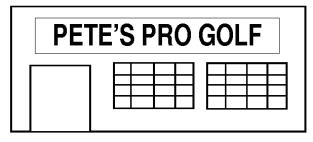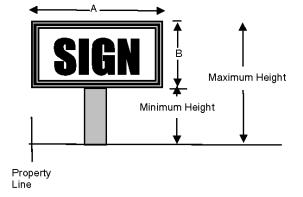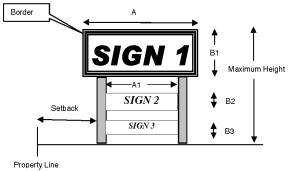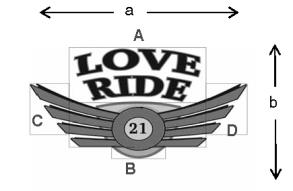Chapter 22.110
SIGN REGULATIONS
Sections:
22.110.010 Purpose, intent and scope.
22.110.040 Number, general regulations for permitted permanent signs.
22.110.060 General provisions applicable to all signs.
22.110.070 Comprehensive sign plan.
22.110.080 Aesthetic corridors.
22.110.090 Sign location and front setbacks.
22.110.100 Sign area calculation.
22.110.110 Maintenance of signs.
22.110.120 Existing nonconforming signs.
22.110.010 Purpose, intent and scope.
Signage regulations are intended to promote commerce, traffic safety and community identity while improving the visual environment of residential, commercial and industrial areas. This code regulates permanent, temporary, and portable signs. (Ord. 13-010 § 3, 2013; Ord. 07-015 § 4, 2007).
22.110.020 Prohibited signs.
The following signs are prohibited:
A. Signs which by coloring, shape, wording or location resemble or conflict with traffic control signs or devices;
B. Signs that create a safety hazard for pedestrian or vehicular traffic;
C. Flashing signs;
D. Portable signs; except A-frame signs and reader boards specifically allowed pursuant to SVMC 22.110.050(A) and (E);
E. Signs located within the public right-of-way, except official signs and except bus benches placed pursuant to an agreement with the City;
F. Signs attached to or placed on a vehicle or trailer parked on public or private property; provided, that this provision shall not be construed as prohibiting the identification of a business or its product on a vehicle operating during the normal course of business;
G. Signs obstructing visibility within any clearview triangle as established in Chapter 22.70 SVMC;
H. Billboards except when permitted as provided in SVMC 22.110.130;
I. Off-premises signs, except off-premises directional signs allowed pursuant to SVMC 22.110.040(D);
J. Temporary signs unless specifically allowed pursuant to SVMC 22.110.050;
K. Abandoned signs and sign structures. (Ord. 13-010 § 3, 2013; Ord. 12-013 § 1, 2012; Ord. 07-015 § 4, 2007).
22.110.030 Permit required.
A. Other than for those uses listed in subsection B of this section, a sign permit is required for all allowed permanent signs, temporary signs, unless otherwise specified, and billboards.
B. Permits are not required for on-premises official signs; seasonal decorations; merchandise displays; point-of-purchase advertising displays; national and state flags; flags of a political subdivision; notice signs, inflatables; flags with copy; reader boards; temporary signs as listed in SVMC 22.110.050; symbolic flags of nonprofit institutions dedicated to public service; legal notices required by law; barber poles; historic site designations; commemorative monuments/plaques; gravestones; advertising copy affixed to phone booths; donation and recycling containers; lettering or symbols applied directly onto or flush-mounted magnetically to a motor vehicle operating in the normal course of business; political signs supporting political issues, candidates or ballot measures; replacement of copy on signs otherwise permitted; name plates with less than four square feet of copy area; directional signs with less than four square feet of copy area; and murals containing no copy.
C. Permit applications shall include a site plan that provides the following information:
1. The location of the affected lot, building(s) and sign(s);
2. The scale of the site plan;
3. The location of all existing signs for the subject applicant including size and height;
4. For signs subject to spacing regulations, the location of neighboring signs on adjacent properties;
5. Approved sign plan, if applicable; and
6. Tax parcel number where proposed sign will be located.
D. Permit applications shall include construction drawings that provide the following information:
1. Two complete sets of scaled drawings of the proposed sign or sign revision, including copy, structural footing details, method of attachment and illumination. A Washington State licensed engineer’s design, stamp and signature are required on each construction drawing for signs over 30 feet in height, pole and monument signs over 100 square feet in sign area regardless of height, flag signs over 10 feet in height regardless of sign area and wall signs where it is determined the size and weight of the sign are factors on the structural integrity of the building or structure. Where special conditions exist for any type of sign, the building official is authorized to require additional construction documents to be prepared by a Washington State licensed engineer and/or special inspections if deemed necessary. (Ord. 13-010 § 3, 2013; Ord. 12-013 § 1, 2012; Ord. 09-010 § 1, 2009; Ord. 07-015 § 4, 2007).
22.110.040 Number, general regulations for permitted permanent signs.
A. Permitted permanent signs shall comply with the requirements of Table 22.110-1. No more than the maximum numbers of either freestanding pole signs or monument sign structures are allowed per parcel.
|
Land Use |
Zoning District |
Maximum |
Side Yard Setback (ft.) |
Permit Required |
Additional Provisions |
||||
|---|---|---|---|---|---|---|---|---|---|
|
Number per Parcel |
Height (ft.) |
Copy Area (ft2) |
Copy Area (ft2)/Lot Frontage < 100 ft. |
Copy Area (ft2) /Lot Frontage > 100 ft. |
|||||
|
Attached Wall Signs |
|||||||||
|
Multifamily Complex |
All Zones |
* |
* |
* |
* |
* |
* |
Y |
One sign up to 20 sq. ft. |
|
Institutional1 |
Residential Zones |
* |
* |
* |
n/a |
n/a |
n/a |
Y |
*25% of wall area |
|
Single Business |
Residential Zones |
1 |
n/a |
60 |
n/a |
n/a |
n/a |
Y |
|
|
Nonresidential |
All Mixed Use and Nonresidential Zones |
* |
n/a |
* |
n/a |
n/a |
n/a |
Y |
*25% of wall area per building |
|
Freestanding Signs |
|||||||||
|
Subdivision/Area Name/Multifamily Complex/Institutional1 |
All Zones |
1* |
10 |
32 |
n/a |
n/a |
n/a |
Y |
*One per 200 ft. of street frontage and 1 for each additional 200 ft. or fraction thereof in nonresidential zones. Additional signs allowed on a multi-business complex site may all be freestanding; additional signs allowed on a single business parcel shall be monument signs |
|
Single Business |
Neighborhood Business (NC) Zones |
1 |
20 |
100 |
n/a |
n/a |
5 |
Y |
|
|
Multi-Business Complex |
1* |
20 |
n/a |
100 |
n/a |
5 |
Y |
||
|
Single Business |
Mixed Use and Nonresidential Zones (except NC) |
1* |
30 |
n/a |
100 |
200 |
5 |
Y |
|
|
Multi-Business Complex |
1* |
40 |
250 |
n/a |
n/a |
5 |
Y |
||
|
Nonresidential Freeway* |
All Nonresidential Zones |
1 |
50 |
250 |
n/a |
n/a |
5 |
Y |
*Adjacent to I-90 only |
|
Monument Signs |
|||||||||
|
Subdivision/Area Name/Multifamily Complex/Institutional1 |
All Zones |
1 |
10 |
32 |
n/a |
n/a |
n/a |
Y |
*Per street frontage |
|
Single Business |
Neighborhood Business (NC) Zones |
1* |
7 |
75 |
n/a |
n/a |
5 |
Y |
|
|
Multi-Business Complex |
2* |
7 |
90 |
n/a |
n/a |
5 |
Y |
||
|
Single Business |
All Mixed Use and Nonresidential Zones |
2* |
7 |
90 |
n/a |
n/a |
5 |
Y |
*Per street frontage |
|
Multi-Business Complex |
2* |
7 |
150 |
n/a |
n/a |
5 |
Y |
||
|
Other Signs |
|||||||||
|
Directional |
All Zones |
n/a |
n/a |
4 |
n/a |
n/a |
n/a |
N |
|
|
Name Plates |
All Zones |
1 |
n/a |
4 |
n/a |
n/a |
n/a |
N |
|
|
1. Institutional includes nonprofit, religious or public uses, such as a church, library, public or private school, hospital, or government owned or operated building, structure, or land used for public purposes. |
|||||||||
B. In addition to the permanent signs allowed pursuant to Table 22.110-1, a single decorative emblem (or standard) constructed of durable vinyl with a thickness of not less than 13 mil for every 50 feet of frontage shall be allowed. The lowest horizontal member of the bracket shall be located at a height of not less than seven feet above the adjacent grade.
C. Where three or more single businesses agree to share a single sign structure, an additional 20 percent of copy area shall be allowed up to a maximum of 250 square feet.
D. Off-Premises Directional Signs. It is the intent of this subsection to allow the limited placement of off-premises directional signs by co-locating on an existing conforming monument sign, freestanding sign, or building wall. A business placing this type of sign on an existing sign shall conform to the following criteria:
1. The business shall be located on a private easement or local access street;
2. The business and proposed sign shall be located in a commercial, office, industrial or mixed zone area;
3. Text shall be limited to the business name, logo, and a directional arrow and may include certain advancing language as “next right”;
4. The sign shall be located on the nearest collector or arterial. If a business has double frontage, staff will review this unique situation to determine if two directional signs are warranted;
5. Sign area shall be limited to 15 square feet. This shall not be construed to allow the on-premises sign to increase its sign area; and
6. If the business using an off-premises directional sign leaves its location, the business shall remove the sign within 60 days.
7. If the site has no existing signage or buildings, then a freestanding sign meeting the requirements above may be allowed. (Ord. 13-010 § 3, 2013; Ord. 12-013 § 1, 2012; Ord. 09-010 § 1, 2009; Ord. 07-015 § 4, 2007).
22.110.050 Temporary signs.
Except as otherwise described under this section, no permit is necessary for temporary signs.
A. Number of Temporary Signs. No more than two of the following signs shall be allowed at any one time for a use, except as permitted in subsection E of this section:
1. One banner; or
2. One reader board; or
3. One flag with copy; or
4. Any combination of the above, not to exceed a total of two signs.
B. Each sign shall be limited to 32 square feet in size.
C. Additional banners or temporary signs advertising a special event, sale, promotion, opening of a new business or a business under new management, including banners, balloons, pennants, flags with copy, streamers, searchlights and inflatables, are allowed by temporary permit for a period of time not to exceed 60 days a maximum of two times in any calendar year.
D. Temporary signs shall not endanger the public safety and shall be removed or relocated if the building official determines that a sign is unsafe.
E. A-Frame Signs. Each business will be allowed a maximum of one sandwich board or A-frame sign. These signs are in addition to other temporary signs allowed through subsections A and C of this section, and are subject to the following conditions:
1. Size. The area of the sign shall not exceed nine square feet per side in size and shall not exceed three feet in any dimension.
2. Maintenance Standards. Signs shall be constructed out of materials able to withstand extreme weather conditions. Such materials may be metal, finished wood, chalkboard, whiteboard or plastic. Signs and copy should be of professional quality. Permanent lettering for the business name and logo is required on the sandwich boards. Owners of sandwich board signs shall be required to keep their signs in an intact, reasonably legible, and well maintained manner. Sandwich boards are not well maintained if any part thereof is broken; letters or graphics are completely or partially missing or obstructed; or the legibility thereof has materially deteriorated.
3. Display Time. If the sign is displayed past daylight hours, precautions should be taken to place the sign in a lighted area. This shall not be construed to allow the wiring of a sign for lighting.
4. Location. Signs shall not be placed in a location which is within the clearview triangle, as defined in SVMC 22.70.020(C), or any other location which will impede vehicular traffic. Further, such signs shall not be placed in a manner which will block or otherwise obstruct the safe use of sidewalks, building entrances or stairs by pedestrians.
F. Temporary on-premises commercial signs are allowed without permit when posted in conjunction with the alteration, construction, sale or lease of real property. Such signs shall not exceed 16 square feet in copy area or seven feet in height. All such signs shall be affixed to either the ground or a permanent structure by rope, wire, or a mechanical device.
G. Open House/Directional Signage. A-frame signs may be used as open house/directional signs and shall be allowed on each access street to the property. Signs shall be placed so as not to interfere with vehicular or pedestrian traffic, shall be used only when the property is open for inspection, shall be unlit, and shall be limited in size to five square feet and limited in height to three feet above grade. (Ord. 13-010 § 3, 2013; Ord. 12-013 § 1, 2012; Ord. 07-015 § 4, 2007).
22.110.060 General provisions applicable to all signs.
A. All signs illuminated with exterior lighting shall have lighting confined to the sign, and positioned and shielded to minimize impacts to the surrounding area(s). Gooseneck reflectors and lights are permitted on permanent freestanding and wall signs; provided, that lighting or glare does not extend beyond the property line.
B. Electronic signs shall be permitted on the same basis as other signs, subject to the requirements of Table 22.110-1. All electronic message centers (EMCs) are required to have automatic dimming capability that adjusts the brightness to the ambient light at all times of the day and night. Written documentation that the EMC is equipped with the automatic dimming device shall be submitted with the sign permit application.
C. A roof-mounted sign may be substituted for an allowed freestanding sign; provided, that the height of the sign structure may not exceed the maximum height requirements of the zoning district in which the sign is located.
D. Signs located within the airport hazard area shall conform to the location and height regulations set forth in SVMC 19.110.030, Airport Hazard Overlay.
E. No sign shall be erected, relocated or maintained in a manner that prevents the free ingress or egress from any door, window or fire escape.
F. No sign shall be attached to a standpipe or fire escape except official signs.
G. Any sign erected or maintained within five feet of public rights-of-way shall be smooth and free of nails, tacks and wires.
H. All signs shall be maintained in good repair pursuant to SVMC 22.110.110.
I. No sign shall block the view of fire protection equipment from approach. (Ord. 13-010 § 3, 2013; Ord. 12-013 § 1, 2012; Ord. 07-015 § 4, 2007).
22.110.070 Comprehensive sign plan.
Commercial development, shopping centers, industrial parks, mixed use developments, and hotel conference centers exceeding five acres in size may seek approval of a sign plan specific to the proposed development. The city manager or designee may approve a comprehensive sign plan that allows deviations from the strict interpretation of spacing, height and area requirements when the following is demonstrated:
A. The plan provides adequate signage for all proposed uses; and
B. The plan limits the number of freestanding sign structures; and
C. The total copy area of all signage does not exceed the amount which would otherwise be permitted.
Any conditions imposed to secure approvals shall be binding on the applicant, his successors and assigns.
Modifications/amendments to the approved sign plan shall require reapplication and approval by the city manager or designee. If the applicant and city manager or designee cannot come to an agreement as to a comprehensive sign plan or a modification/amendment to the same, the city manager or designee’s decision may be appealed to the hearing examiner pursuant to Chapter 17.90 SVMC. (Ord. 17-004 § 3, 2017; Ord. 13-010 § 3, 2013; Ord. 07-015 § 4, 2007).
22.110.080 Aesthetic corridors.
The standards applicable to wall-mounted and monument signs shown in Table 22.110-1 shall apply to parcels adjacent to the aesthetic corridors identified below. Other permanent signs shall not be permitted on such parcels. Areas within the aesthetic corridors include:
A. State Route 27 (16th Avenue south to City limits);
B. State Route 27 (Mansfield Avenue to Trent Avenue);
C. Appleway Boulevard (south side only from Park Road to Dishman Mica Road);
D. Appleway Avenue (Barker Road to Hodges Road);
E. Dishman Mica Road (8th Avenue south to City limits);
F. 32nd Avenue within the City limits;
G. Mirabeau Parkway (Pines Road to Indiana Avenue). (Ord. 20-001 § 3, 2020; Ord. 13-010 § 3, 2013; Ord. 07-015 § 4, 2007).
22.110.090 Sign location and front setbacks.
A. Monument signs exceeding three feet in height shall be set back 10 feet from the front property line and outside any border easement; provided, that the requirements of Chapter 22.70 SVMC, Fencing, Screening and Landscaping (clearview triangles), have been met.
B. Freestanding signs with structural supports less than two feet in width, with copy area placed at a height of seven feet or more above grade, may be located at the property line; provided, that the requirements of Chapter 22.70 SVMC, Fencing, Screening and Landscaping (clearview triangles), of the Spokane Valley Municipal Code have been met. Freestanding signs with structural supports of more than two feet shall be set back not less than 10 feet from the front property line or border easement.
C. All temporary signs, except inflatable signs, shall be located at least five feet from public rights-of-way.
D. Inflatable signs shall be set back at least 10 feet from public rights-of-way.
E. All signs shall meet the vertical and horizontal clearance requirements of electric utilities.
F. All new freestanding signs shall comply with SVMC 22.70.030(J), Landscaping Requirements for Freestanding Signs. (Ord. 13-010 § 3, 2013; Ord. 07-015 § 4, 2007).
22.110.100 Sign area calculation.
A. Sign area for wall signs shall be no more than 25 percent of the two-dimensional area of a building’s elevation, excluding eaves and gables. Refer to Table 22.110-1.
Figure 22.110-1
Figure 22.110-2
Figure 22.110-3
B. The sign area of a freestanding sign for a single business shall be calculated as shown in Figure 22.110-2. The sign area of a freestanding sign identifying multiple businesses shall be computed by adding together the total area(s) of all signs as shown in Figure 22.110-3. Refer to Table 22.110-1 for minimum and maximum height requirements.
C. The sign area for multiple-sided signs shall be calculated as follows:
1. The total sign area for a two-sided sign shall be calculated using a single surface of a sign with messages on both sides;
2. The sign area for a three-sided sign shall be the sum of all surfaces where two or more signs share a single structure;
3. The gross surface area of both faces of a V-shaped sign;
4. The copy area of a monument sign.
D. For irregularly shaped signs, the sign area is calculated by enclosing the extreme limits of the sign by no more than four rectangles. The sum of the area of the rectangles shall be the gross surface area. The maximum allowable area is reduced by 10 percent for the second and each subsequent rectangle used in the calculation, illustrated below.
1. Conventional Measurement. Total area = a times b.
2. Sum of Rectangles. Total area = (Area A + Area B + Area C + Area D). (Ord. 13-010 § 3, 2013; Ord. 07-015 § 4, 2007).
22.110.110 Maintenance of signs.
A. All signs shall be maintained in good repair. The city manager or designee shall have the authority to revoke any permit for signs that are tattered, torn, faded or otherwise in disrepair, and may require the removal of banners, flags, reader boards, pennants and streamers which are torn, discolored or in disrepair.
B. All signage shall be maintained by the business owner, or person in possession of the property on which the sign is located. Maintenance shall be such that the signage continues to conform to the conditions imposed by the sign permit.
C. Any damaged sign structure shall be repaired within 30 days of notice.
D. Any signage which has been damaged to such extent that it may pose a hazard to passersby shall be repaired or removed within 48 hours of notice.
E. Any abandoned sign shall be removed by and at the expense of the property owner within 60 days of notice.
F. Any abandoned sign support structure shall be removed within 36 months by the owner or lessee of the premises upon which the sign is located. (Ord. 17-004 § 3, 2017; Ord. 13-010 § 3, 2013; Ord. 07-015 § 4, 2007).
22.110.120 Existing nonconforming signs.
Any permanent sign made nonconforming as a result of the adoption of these regulations may be repaired, but not structurally altered or made more nonconforming in any way. If the sign is removed in order to make repairs, it shall be replaced within 60 days, or any nonconforming rights are terminated. Thereafter, the sign shall conform to the requirements of this chapter.
Notwithstanding other provisions of this section, any sign or signs for which a temporary permit has been issued by the City shall be permitted to remain at the location or locations authorized by the permit for as long as the permit is valid and all the requirements of the permit have been met. (Ord. 13-010 § 3, 2013; Ord. 07-015 § 4, 2007).
22.110.130 Billboards.
A. New billboards shall be prohibited; provided, however, that existing billboards may be replaced at another location with a structure and copy area of equal or smaller size in mixed use and nonresidential zoning districts except (NC) Neighborhood Commercial zoning districts as follows:
1. Replacement billboards shall not exceed the height limit in the underlying zoning district, with a maximum height limit of 50 feet in any zone;
2. No replacement billboard shall exceed 672 square feet in copy area;
3. Any replacement billboard may not be placed less than five feet from the property line. No portion of the sign shall extend beyond the property line;
4. No billboard may be located within 1,000 feet of another billboard on the same side of the street. Any replacement billboard shall be offset from any billboard on the opposite side of the street by not less than 250 feet. Offset distance shall be measured from a point perpendicular to and along the alignment of the roadway;
5. The owner of the billboard shall file a complete inventory of all billboards located within the City, including date erected, height, size and location;
6. Issuance of a permit for billboard replacement shall be accompanied by a permit for the destruction or removal of the billboard to be replaced; and
7. Any billboard that is not replaced within five years following the issuance of a demolition/removal permit shall not be replaced.
B. Replacement billboards shall not be permitted along designated aesthetic corridors. (Ord. 13-010 § 3, 2013; Ord. 07-015 § 4, 2007).


